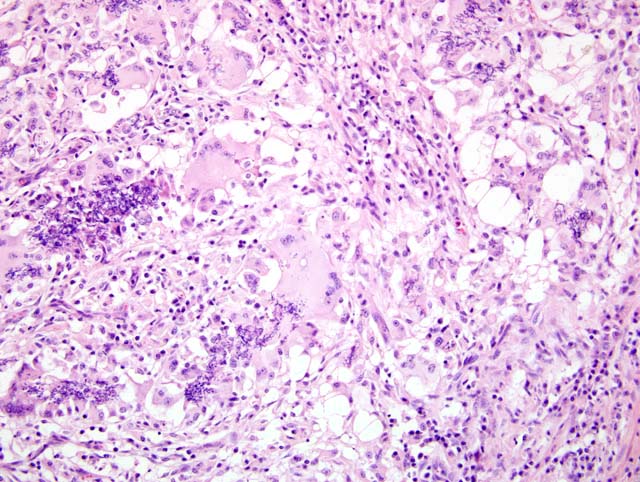Signalment:
Gross Description:
Histopathologic Description:
Morphologic Diagnosis:
Lab Results:
Condition:
Contributor Comment:
In this particular case, additional sections of epididymis, prostate gland and seminal vesicle displayed mild multifocal accumulations of neutrophils, which were presumed incited by ascending infection of Actinobacillus seminis.
JPC Diagnosis:
1. Epididymis: Epididymitis, granulomatous, focally extensive, moderate with a sperm granuloma
2. Epididymis: Epithelial hyperplasia, multifocal, moderate
Conference Comment:
Sperm are produced within the testes and inside the seminiferous tubules. Sperm travel through a plexus of channels called the rete testes. From the rete testes, numerous small efferent ductules transport sperm to the head of the epididymis. Within the head and body of the epididymis sperm undergo changes that transform them into fertile cells. Sperm traverse the head and body over a period of several days, and eventually reach the tail of the epididymis for storage prior to ejaculation via the ductus deferens.(2) The contributor mentioned the highly antigenic nature of sperm; any release of sperm into the extratubular compartment leads to a foreign body type reaction. This is followed by a strong immune response resulting in an accumulation of large numbers of plasma cells, CD4 and CD8 positive lymphocytes, and an up-regulation of MHC I in epithelial cells. As in the case of a foreign body, a chronic immune response leads to fibrosis and walling off of the lesion. This often leads to spermiostasis, a spermatocele, or a sperm granuloma.(1)
The known causes of sperm granulomas were discussed; they include congenital duct anomalies, adenomyosis, trauma, and infections. Bacteria are implicated most frequently, as mentioned by the contributor, and the route of infection is via ascension from the urethra and accessory sex glands. The immunologically privileged site allows for the organism to proliferate unabated. This often leads to formation of a sperm granuloma and loss of fertility.(1)
There was extensive slide variation with this particular case. The contributor mentioned distinct mineralization and Splendore-Hoeppli like reaction at the center of the foci which was not present on all of the submitted slides.
References:
2. Senger PL: Pathways to Pregnancy and Parturition, 1st ed., pp. 32-57. The Mack Printing Group-Science Press, Ephrata, PA, 1997
